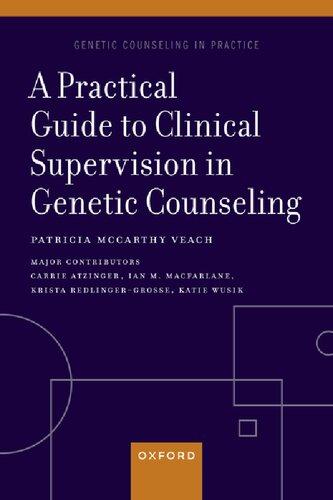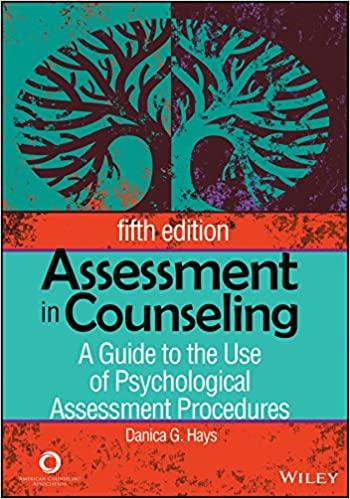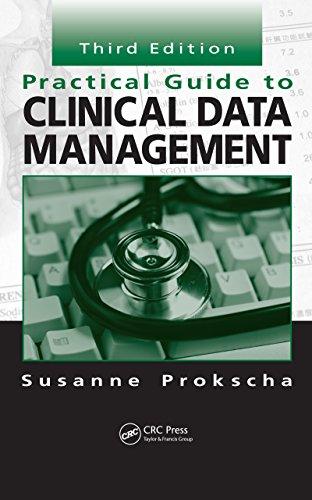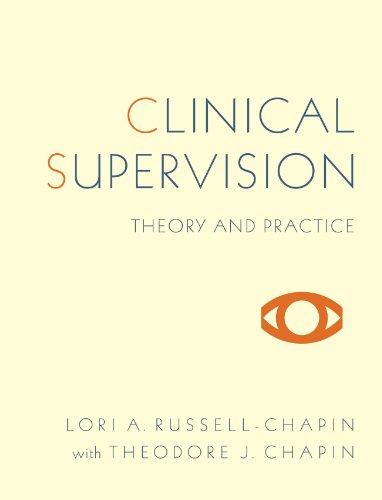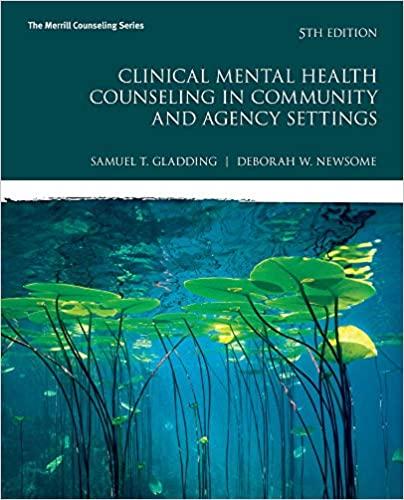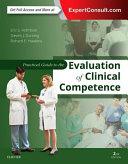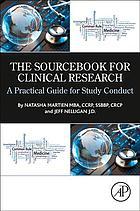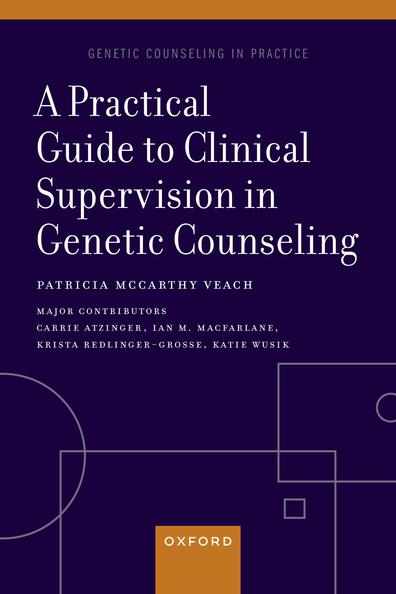A Practical Guide to Clinical Supervision in Genetic Counseling
Patricia McCarthy Veach
Distinguished Teaching Professor Emerita Department of Educational Psychology
University of Minnesota Minneapolis, MN, USA
Oxford University Press is a department of the University of Oxford. It furthers the University’s objective of excellence in research, scholarship, and education by publishing worldwide. Oxford is a registered trade mark of Oxford University Press in the UK and certain other countries.
Published in the United States of America by Oxford University Press 198 Madison Avenue, New York, NY 10016, United States of America.
© Oxford University Press 2023
All rights reserved. No part of this publication may be reproduced, stored in a retrieval system, or transmitted, in any form or by any means, without the prior permission in writing of Oxford University Press, or as expressly permitted by law, by license, or under terms agreed with the appropriate reproduction rights organization. Inquiries concerning reproduction outside the scope of the above should be sent to the Rights Department, Oxford University Press, at the address above.
You must not circulate this work in any other form and you must impose this same condition on any acquirer.
Library of Congress Cataloging-in-Publication Data
Names: Veach, Patricia McCarthy, author.
Title: A practical guide to clinical supervision in genetic counseling / Patricia McCarthy Veach.
Other titles: Genetic counseling in practice.
Description: New York, NY : Oxford University Press, [2023] | Series: Genetic counseling in practice | Includes bibliographical references and index.
Identifiers: LCCN 2022034961 (print) | LCCN 2022034962 (ebook) | ISBN 9780197635438 (paperback) | ISBN 9780197635452 (epub) | ISBN 9780197635469 (online)
Subjects: MESH: Genetic Counseling—organization & administration | Personnel Management—standards | Staff Development—standards | Administrative Personnel—standards | Administrative Personnel—ethics Classification: LCC RB155.7 (print) | LCC RB155.7 (ebook) | NLM QZ 52 | DDC 362.196/042—dc23/eng/20220902
LC record available at https://lccn.loc.gov/2022034961
LC ebook record available at https://lccn.loc.gov/2022034962
DOI: 10.1093/med/9780197635438.001.0001
This material is not intended to be, and should not be considered, a substitute for medical or other professional advice. Treatment for the conditions described in this material is highly dependent on the individual circumstances. And, while this material is designed to offer accurate information with respect to the subject matter covered and to be current as of the time it was written, research and knowledge about medical and health issues is constantly evolving and dose schedules for medications are being revised continually, with new side effects recognized and accounted for regularly. Readers must therefore always check the product information and clinical procedures with the most up-to-date published product information and data sheets provided by the manufacturers and the most recent codes of conduct and safety regulation. The publisher and the authors make no representations or warranties to readers, express or implied, as to the accuracy or completeness of this material. Without limiting the foregoing, the publisher and the authors make no representations or warranties as to the accuracy or efficacy of the drug dosages mentioned in the material. The authors and the publisher do not accept, and expressly disclaim, any responsibility for any liability, loss, or risk that may be claimed or incurred as a consequence of the use and/or application of any of the contents of this material.
Contents
Preface | xix
About the Authors | xxi
Contributors | xxiii
1. Introduction to Supervision Theory and Practice | 1
Patricia McCarthy Veach
Objectives | 1
What Is Clinical Supervision? | 1
Who Does Supervision Serve? | 3
Reciprocal Engagement Model of Supervision | 5
REM- S Tenets and Goals | 7
REM- S Supervisor Strategies | 8
Supervisor Competencies | 9
Supervision Is Hierarchical | 18
Why Serve as a Supervisor? | 19
Closing Thoughts | 20
Learning Activities | 20
Activity 1.1 Supervisor Self-Assessment | 20
Activity 1.2 Reflecting on Supervision | 21
Activity 1.3 Wearing Different Supervisor Hats | 21
Activity 1.4 Genetic Counseling Supervisor Competencies | 22
Activity 1.5 REM- S Goals | 24
Appendix 1A: Genetic Counseling Supervisor
Competencies | 25
Appendix 1B: The Psychotherapy Supervisor Development Scale | 36
2. Supervisory Styles | 39
Patricia McCarthy Veach
Objectives | 39
Stylistic Differences | 39
Consultation Style | 41
Teaching Style | 42
Counseling Style | 43
Evaluation Style | 44
Style Limitations | 45
Additional Comments About Supervisory Styles | 47
Behaviors Common to Supervisory Styles | 49
Closing Thoughts | 50
Learning Activities | 51
Activity 2.1 Identifying Supervisory Styles | 51
Activity 2.2 Using Supervisory Styles | 52
Activity 2.3 Supervisory Focus and Style | 54
Activity 2.4 Supervision Metaphors | 57
Activity 2.5 The Counselor Supervisory Style | 57
Activity 2.6 Supervisory Styles: Triad Role Plays | 58
Appendix 2A: Learning Activities Answer Key | 60
3. Setting the Stage for Supervision | 61
Patricia McCarthy Veach
Objectives | 61
Initiating the Supervisory Relationship | 61
Building a Supervision Working Alliance | 61
Prepping for Supervision: Anticipatory Guidance Strategies | 63
Student and Supervisor Questions | 64
Supervision Information Statements and Agreements | 66
Additional Strategies to Set the Stage for Supervision | 67
Closing Thoughts | 70
Learning Activities | 70
Activity 3.1 Working Alliance Factors | 71
Activity 3.2 Prepping for Supervision— Getting Started | 71
Activity 3.3 Prepping for Supervision—Anticipating Student Questions | 72
Activity 3.4 Challenging Student Questions | 72
Activity 3.5 Supervision Information Statement/ Agreement | 72
Appendix 3A: Genetic Counseling Student Questions About Supervision | 73
Appendix 3B: Genetic Counselor Supervisor Questions About Students | 80
Appendix 3C: Sample Information Sheet | 82
Appendix 3D: Sample Information Agreement | 85
4. Culturally Engaged Supervision | 89
Ian M. MacFarlane and Krista Redlinger- Grosse
Objectives | 89
Introduction | 89
Important Terminology | 91
Culture | 91
Cultural Competence | 92
Cultural Humility | 93
Cultural Engagement | 94
Additional Terms | 94
Foundations in Theory and Research | 95
Culturally Engaged Supervision: Applications and Strategies | 96
Starting Point: Cultural Self-Awareness | 98
Entry Points: Communication | 100
Challenging Issues: Microaggression/ Racism | 109
Continuing the Work | 113
Closing Thoughts | 114
Learning Activities | 115
Activity 4.1 Cultural Self-Awareness | 115
Activity 4.2 Communication Style Dimensions | 116
Activity 4.3 Culture Sharing in Supervision: Dyad Role Plays | 116
Activity 4.4 Challenging Situations: Dyad Role Plays | 117
Activity 4.5 Culturally Engaged Supervision | 118
Appendix 4A: Cultural Identities and Their Intersection | 122
Appendix 4B: Communication Style Dimensions | 123
Appendix 4C: Culture Sharing Worksheet | 125
5. Models of Supervisor and Student Development | 129
Patricia McCarthy Veach
Objectives | 129
Supervisor and Supervisee Developmental Models | 129
Supervisor Models | 130
Common Themes in Supervisor Models | 134
Supervisee Developmental Models | 135
Supervisor and Supervisee Developmental Challenges: Parallel Processes | 136
Developmentally Based Interventions for Supervisors | 141
Developmentally Based Interventions for Students | 144
Engage in Assessment | 144
Match Interventions to Developmental Level | 144
Use Examples | 145
Assign Scaffolding Tasks/ Experiences | 145
Counseling Independently | 148
Assess Student Readiness | 148
Prepare Students to Counsel Independently | 150
Prepare Yourself for Students to Counsel Independently | 151
Closing Thoughts | 152
Learning Activities | 152
Activity 5.1 Supervisor Development Self-Reflection | 153
Activity 5.2 Supervisor Development Self-Assessment | 153
Activity 5.3 Experiential Evolutionary Scaffolding | 154
Activity 5.4 Addressing Student Developmental Issues: Triad Role Plays | 154
Activity 5.5 Supervisor and Student Developmental Stages | 156
6. Setting Goals in Supervision | 157
Patricia McCarthy Veach
Objectives | 157
What Are Goals and Why Are They Useful? | 157
Types of Performance Goals | 158
Characteristics of Viable Goals | 159
Goal- Setting Processes | 159
Determining Goal Content | 160
Establishing Goal Levels: Bloom’s Taxonomy | 161
Goal- Setting Strategies | 163
Establish Long- and Short-Term Goals | 163
Regularly Review Long- and Short-Term Goals | 165
Make Goal Setting a Collaborative and Focused Process | 165
Modify Goals as Appropriate | 167
Recognize and Manage Common Goal- Setting Pitfalls | 167
Evaluate Your Goal- Setting Skills | 169
Strategies for Promoting Goal Accomplishment | 170
Mind Mapping | 170
Closing Thoughts | 173
Learning Activities | 173
Activity 6.1 Writing Viable Goals | 173
Activity 6.2 Connecting Goals to Behaviors and Goal
Measurement | 174
Activity 6.3 Writing Goals Using the Discrimination Model and Bloom’s Taxonomy | 175
Activity 6.4 Mind Mapping to Promote Goal/Strategy
Accomplishment | 176
Activity 6.5 Setting and Prioritizing Short-Term Goals | 177
7. Giving and Receiving Feedback | 179
Patricia McCarthy Veach
Objectives | 179
Types of Feedback | 180
Positive Feedback | 180
Corrective Feedback | 181
Characteristics of Helpful Feedback | 183
Strategies for Promoting Helpful Feedback Interactions | 184
Create a Framework for Feedback | 185
Use Evocative Feedback Strategies When Feasible | 187
Shape Students’ Self- Critique Skills | 188
Provide Timely Feedback | 189
Be Honest and Direct | 189
Provide Sufficient, Balanced Feedback | 190
Be Strategic, Selective, and Sensitive to Student Reactions | 193
Provide Specific Feedback and Place It in a Context | 193
Recognize Corrective Feedback May Take Time to “Land” | 194
Provide Oral and Written Feedback | 195
Feedback Regarding the Supervisor and Supervision Relationship | 197
Supervisor Self-Feedback | 198
Student Feedback | 198
Closing Thoughts | 198
Learning Activities | 199
Activity 7.1 Reflecting on Feedback | 199
Activity 7.2 Feedback Challenges and Strategies | 200
Activity 7.3 Challenging Student Responses to Feedback | 200
Activity 7.4 Challenging Supervisor Feedback Statements | 201
Activity 7.5 Giving Feedback: Triad Role Plays | 202
8. Evaluation in Supervision | 205
Carrie Atzinger
Objectives | 205
Evaluation Functions and Criteria | 206
Formative Versus Summative Evaluation | 207
Evaluation Criteria | 207
Approaches to Student Evaluation | 208
Likert- Style Evaluations | 208
Anchored Rubrics | 209
Qualitative Feedback | 214
Client Feedback | 214
Student Self-Evaluation | 215
Evaluation Challenges | 216
Subjectivity | 216
Power Dynamics | 217
Strategies for Promoting an Effective Evaluation Process | 217
Evaluating the Supervisor | 219
Closing Thoughts | 219
Learning Activities | 220
Activity 8.1 Summative Versus Formative Evaluation | 220
Activity 8.2 Skill- Specific Anchored Rubrics | 220
Activity 8.3 Evaluating Student Goals | 221
Activity 8.4 Qualitative Final Evaluation: Triad Role Plays | 222
Activity 8.5 Client Feedback Forms | 223
Appendix 8A: Genetic Counseling Self-Efficacy Scale | 223
9. Supervision for Self-Reflective Practice | 227
Patricia McCarthy Veach
Objectives | 227
What Is Self-Reflective Practice? | 227
Self-Reflection in Supervision | 229
Strategies for Promoting Student Self-Reflective Practice | 229
Cultivate and Model Your Own Self-Reflection Skills | 230
Set the Stage with Directed Self-Reflection Protocols | 231
Work on Minimizing Barriers to Student Reflective Practice | 234
Use Evocative Strategies | 238
Give Students Self-Reflection Assignments to Complete Outside of Supervision Meetings | 239
Debrief Role Plays and Counseling Sessions Using Interpersonal Process Recall | 240
Use Processes from Socratic Dialogue During Supervision | 241
Closing Thoughts | 244
Learning Activities | 244
Activity 9.1 Creating a Self-Directed Protocol | 245
Activity 9.2 Engaging in Socratic Dialogue | 245
Activity 9.3 Supervision Self-Reflection | 246
Activity 9.4 Interpersonal Process Recall Debriefing: Role Plays | 246
Activity 9.5 Using Evocative Strategies in Supervision: Triad Role Plays | 247
10. Fostering Psychosocial Skill Development | 249
Patricia McCarthy Veach
Objectives | 249
What Are Psychosocial Skills and Why Are They Important? | 249
Types of Psychosocial Skills | 252
Strategies for Building Students’ Psychosocial Skills | 257
Discuss Definitions and Perspectives | 257
Recognize and Address Barriers to Using Psychosocial Skills | 258
Assess Student Psychosocial Skills | 262
Set Developmentally Appropriate Goals | 262
Model Psychosocial Skills | 263
Use Directed Self-Reflection Protocols | 263
Assign Psychosocial Case Preparations | 263
Engage in Role Playing | 264
Debrief with Interpersonal Process Recall Methods | 265
Use Mind Mapping Methods | 266
Connect Psychosocial Skills to Their Effects | 266
Closing Thoughts | 268
Learning Activities | 268
Activity 10.1 Addressing Student Misperceptions About Psychosocial Skills | 268
Activity 10.2 Psychosocial Case Preparations | 269
Activity 10.3 Directed Self-Reflection Protocol | 270
Activity 10.4 Mind Mapping | 270
Activity 10.5 Addressing Students’ Use of Psychosocial Skills: Triad Role Plays | 271
11. Ethics and Professionalism in Supervision | 273
Patricia McCarthy Veach
Objectives | 273
Supervisor Responsibilities | 273
Ethical Considerations in Clinical Supervision | 274
Supervision Agreement | 274
Modeling | 276
Multiple Relationships | 277
Boundary Crossings and Boundary Violations | 278
Additional Issues | 280
Strategies to Promote Ethical and Professional Supervision Practice | 281
Make a Lifelong Commitment to Ethical Awareness, Sensitivity, and Behavior | 281
Set and Maintain Clear Boundaries Around the Supervision Relationship | 282
Manage Multiple Relationships in an Ethical Manner | 285
Delineate and Enforce Your Expectations of Students | 287
Develop a Strong Supervisory Working Alliance | 288
Closing Thoughts | 288
Learning Activities | 288
Activity 11.1 Addressing Student Questions About Ethical and Legal Aspects of Supervision | 289
Activity 11.2 Boundaries in Supervision
Discussion | 289
Activity 11.3 Strategies for Addressing Boundary Issues in Supervision | 290
Activity 11.4 Addressing Ethical Situations: Triad Role
Plays | 291
Activity 11.5 Ethical Decision-Making | 292
12. Promoting Student Wellness | 293
Patricia McCarthy Veach
Objectives | 293
What Is Wellness? | 293
Resilience | 294
Self- Care | 294
The Role of Supervision in Promoting Student Wellness and Self- Care | 296
Stress and Distress | 296
Supervisor Responsibilities | 297
Wellness and Self- Care Strategies | 300
General Strategies | 300
Genetic Counselor Wellness Strategies | 302
Specific Strategies | 303
Tips for Promoting Student Self- Care Practices | 307
Closing Thoughts | 308
Learning Activities | 308
Activity 12.1 Self- Care Practices | 309
Activity 12.2 Assessing Student Wellness | 309
Activity 12.3 Setting Wellness Goals | 310
Activity 12.4 Sources of Stress and Stress
Management | 310
Activity 12.5 Self- Care Behavior | 311
Appendix 12A: Self- Care Behavior Inventory | 311
13. Recognizing and Addressing Student Problematic Performance | 313
Patricia McCarthy Veach
Objectives | 313
What Is Problematic Performance? | 314
Problematic Performance Indicators | 315
Types of Problematic Performance | 316
Addressing Problematic Performance | 318
Identify Barriers to Addressing Student Behaviors | 319
Follow a Deliberate Process | 320
Prepare Yourself for Initial Conversations | 323
Be Planful and Deliberate During Conversations | 325
Additional Strategies to Support Remediation Efforts | 326
Closing Thoughts | 327
Learning Activities | 327
Activity 13.1 Remediation Conversations | 328
Activity 13.2 Problematic Performance | 328
Activity 13.3 Barriers to Supervision | 329
Activity 13.4 Addressing Student Problematic Performance | 330
Activity 13.5 Developing an Intervention to Improve Student Problematic Performance | 331
14. Common Clinical Supervision Challenges | 333
Patricia McCarthy Veach
Objectives | 333
Supervisor– Student Conflict | 334
Types of Supervision Conflicts | 334
Conflict Management Strategies | 335
Example of Addressing a Conflict: Student Autonomy Versus Imitation | 337
Supervisor Countertransference | 338
Sources of Supervisor Countertransference | 339
Types of Countertransference | 339
Behaviors That Suggest Countertransference | 341
Strategies to Manage Countertransference | 341
Example of Addressing Countertransference: Disliking a Student | 344
Student Anxiety | 345
Types and Sources of Anxiety | 346
Behaviors Suggestive of Anxiety | 346
Anxiety Management Strategies | 349
Example of Addressing One Source of Student Anxiety: Multiple Supervisors | 350
Closing Thoughts | 352
Learning Activities | 352
Activity 14.1 Conflict in Supervision | 352
Activity 14.2 Countertransference Self-Reflection | 353
Activity 14.3 Addressing Countertransference | 353
Activity 14.4 Student Anxiety | 355
Activity 14.5 Addressing Student Anxiety | 355
15. Supervision Delivery Methods | 357
Katie Wusik
Objectives | 357
Live Supervision | 358
Live Supervision Advantages | 359
Live Supervision Challenges | 360
Other Considerations Regarding Live Supervision | 362
Self-Report | 362
Self-Report Advantages | 362
Self-Report Challenges | 363
Integrating Self-Report into Genetic Counseling Supervision | 364
Standardized Patients | 364
Standardized Patient Advantages | 365
Integrating Standardized Patients into Genetic Counseling Supervision | 366
Peer Group Supervision | 367
Peer Groups for Professionals | 367
Peer Groups for Students | 368
Peer Observation and Feedback | 368
Remote Supervision | 369
Closing Thoughts | 372
Learning Activities | 373
Activity 15.1 Reflections on Supervision Delivery Methods | 373
Activity 15.2 Challenges in Live Supervision | 374
Activity 15.3 Client Reactions to Student Involvement | 374
Activity 15.4 Generating Questions for Self-Report | 375
Activity 15.5 Creating Guidelines for Peer Supervision Groups | 375
Appendix: Instructional Tips for Building Supervision
Training Opportunities | 377
References | 383
Index | 407
Preface
Genetic counseling supervision is central to student professional development, and it is a prevalent activity among genetic counselors. Genetic counselors without question are experts at providing genetic counseling services. A good practitioner, however, is not automatically a good supervisor. Although there are many parallels between genetic counseling practice and supervision, they are not the same activities. Genetic counseling literature supports formal training for supervisors to increase their confidence and maximize their supervision skills. Furthermore, the Accreditation Council for Genetic Counseling (ACGC; 2019a), which endorses genetic counseling graduate programs in North America, requires programs to prepare students to “understand the methods, roles and responsibilities of the process of clinical supervision of trainees” (p. 7).
This book is intended to serve as a practical resource to inform educational efforts and to promote individual supervisors’ professional development. Each chapter offers specific suggestions and experiential activities for strengthening and maintaining competencies that promote effective supervision processes and outcomes. The content is pertinent for individual readers and for workshop and classroom instruction. The Appendix, “Instructional Tips for Building Supervision Training Opportunities,” contains
general suggestions to facilitate the learning experiences of current and future genetic counseling supervisors.
There are four important considerations. First, the book emphasizes student supervision, but basic concepts and skills are relevant for individuals providing supervision to all types of supervisees. Second, the content is applicable for individuals at varying levels of supervision experience— students, novice and experienced supervisors, and individuals interested in becoming supervisors. Third, readers will see the terms “client” and “patient” throughout the chapters. “Client” is consistent with revisions to the ACGC standards and Practice-Based Competencies. This term reflects the variety of settings in which genetic counseling practice and supervision occur. “Patient” is consistent with terminology used in cited publications. Fourth, it is possible that some readers will expect supervisors to masterfully utilize every approach described in this book. Perfectionistic expectations not only cause undue stress but also impede supervision processes and outcomes. This book is informed by firsthand experiences conducting clinical supervision trainings and providing supervision, as well as existing literature on clinical supervision. Several individuals merit particular recognition: Carrie Atzinger, Ian M. MacFarlane, Krista Redlinger- Grosse, and Katie Wusik shared their expertise by serving as authors for three chapters. Carrie also provided valuable editorial suggestions for other chapters. Nancy Callanan, Bonnie LeRoy, and Casey Reiser (advisors to the book) and Bonnie Baty and Angie Trepanier (genetic counseling series co- editors) are deeply experienced genetic counselors, supervisors, educators, and researchers who reviewed chapter drafts and provided insightful suggestions that enhanced the final product. Finally, I thank the supervisors, practitioners, and students I have had the privilege to work with throughout the years; their perspectives have greatly enriched my understanding of clinical supervision.
Patricia McCarthy Veach, PhD, LP
Introduction to Supervision Theory and Practice
PATRICIA MCCARTHY VEACH
Objectives
• Define supervision and its functions.
• Present the Reciprocal-Engagement Model of Supervision (REM- S).
• Describe empirically derived genetic counseling supervisor competencies.
• Explain the importance of genetic counselors taking on the role of supervising students.
What Is Clinical Supervision?
When you hear the term supervision, what comes to mind? Maybe you think of words such as guidance, support, advice, teaching, consultation, feedback, and evaluation. Supervision can be any of these things in different situations with different supervisees. As such, supervision is a complex activity requiring deliberate self-reflective practice. Furthermore, although there is a certain amount of overlap, the skills of effective supervision are distinct from the skills of genetic counseling practice.
Clinical supervision is the lynchpin of student preparation in human services professions. Many descriptions of this essential activity exist—for example:
[Supervision is] a highly significant activity of mentoring, guiding, and shaping the next generation of competent [genetic counselors].
GRANT ET AL. (2012, P. 539)
Clinical supervision is an intervention provided by a more senior member of a profession to a more junior colleague or colleagues who typically (but not always) are members of the same profession. This relationship is evaluative and hierarchical, extends over time, and has the simultaneous purposes of enhancing the professional functioning of the more junior person(s); monitoring the quality of professional services offered to the clients, that she, he, or they see; and serving as a gatekeeper for the particular profession the supervisee seeks to enter.
BERNARD AND GOODYEAR (2014, P. 9)
Clinical supervision is an essential component of genetic counseling education, serving three primary purposes: (1) promoting the professional development of student supervisees who are the genetic counselors of the future, (2) ensuring continued provision of quality professional services, and (3) serving a gate keeper function regarding those individuals who enter the profession.
MCCARTHY VEACH AND LEROY (2009, P. 401)
Clinical supervision serves to teach, through reflective practice, how to convey genetic information in an understandable, informative and sensitive manner so patients can make informed decisions about genetic testing and management for their conditions.
WHERLEY ET AL. (2015, P. 702)
These descriptions characterize clinical supervision functions and processes as
• a means of transmitting skills, knowledge, and attitudes of a particular profession through a focus on behavior (Bernard & Goodyear, 2014; Grant et al., 2012; Wherley et al., 2015);
• a relationship in which one person’s skills/professional identity are enhanced by interaction with another (Grant et al., 2012);
• an ongoing process in which one experienced person helps another person acquire and maintain appropriate professional/work behavior (Weil, 2000);
• an essential way of ensuring clients receive a standard of care (Bernard & Goodyear, 2014; McCarthy Veach & LeRoy, 2009); and
• an activity that fosters professional development across an individual’s career (see “Peer Group Supervision” in Chapter 15).
Who Does Supervision Serve?
Supervision serves several constituents (McCarthy Veach & LeRoy, 2009): students, the students’ current and future genetic counseling clients, genetic counseling training programs, the genetic counseling profession, and supervisors. The needs of these various constituents require supervisors to wear several “hats” (Bernard & Goodyear, 2014): Supervisors are skill builders, helping students develop and maintain skills required of entry-level genetic counselors. They are socializers, helping students learn and adopt values, attitudes, and behaviors consistent with the genetic counseling profession. Supervisors are monitors of services provided by students to ensure a standard of care for clients and other consumers of genetic counseling services. They are gatekeepers, contributing to decisions about who has the necessary characteristics and skills to enter the profession.
A colleague of mine has said, “Genetic counseling is easy, it’s genetic counseling student supervision that’s challenging.” Why is that? I think it is partly because of those multiple hats. Every action we engage in as supervisors should be to serve the needs of our constituents, but sometimes those needs compete. I recommend you inform students at the beginning of your relationship about the nature of the various hats you wear (see the discussion of information agreements in Chapter 3). Furthermore, to minimize misunderstandings, it sometimes helps to tell a student when you are switching hats. For example:
Scenario: The supervisor and student agreed the student would present testing options to the client, but during that part of the counseling session, the supervisor stepped in. Later, when debriefing the session, the student brought up the step-in.
Student : You told the client about whole exome sequencing, and I was just getting to that.
Supervisor : I know you were well- prepared to present all of the options, and you’re disappointed about not getting to do that. Because we were running short on time, I put on my “client care” hat and stepped in. Presenting information within a set time frame is challenging. In retrospect, what do you think you might have done differently to present options more concisely?
[Student offers some ideas, and the supervisor reinforces feasible ones and adds their own thoughts.]
Supervisor : Why don’t we role play the part of the session where you presented options, so you can try out some of these ideas.
In this example, the supervisor acknowledges the student’s disappointment/frustration, clarifies the step-in was not because the student was unprepared, and identifies time management as the reason for the step-in. They go on to normalize the challenging nature of time management, elicit the student’s thoughts about
how to do things differently, and suggest a practice opportunity. Of note, it is generally a good idea to discuss “step- ins” during debriefings because students may have very different ideas about why you stepped in and what it “says” about their performance.
Reciprocal Engagement Model of Supervision
If I have a [model], I will have a method. I will know what to look for, what to do, and when to do it. I will be able to justify my intervention.
JANSON (1998, P. 46)
A model of supervision practice provides a conceptual framework for “initiation of the supervision relationship, identification of goals and tasks, and evaluation of supervision processes and outcomes . . . [and] can promote consistency in student training and evaluation within and across genetic counseling programs” (Wherley et al., 2015, p. 703). A model of supervision creates a framework for a seemingly overwhelming endeavor (Kennedy, 2000a). A model also contributes to the “safety net” valued by genetic counseling students to ensure quality client care while allowing students to develop new skills (Hendrickson et al., 2002).
In 2007, McCarthy Veach et al. published an empirically derived Reciprocal-Engagement Model (REM) of clinical genetic counseling practice (shown in Figure 1.1). They based the model on a consensus meeting of genetic counseling program directors or their representatives, key informants, and a review of literature. The REM consists of three key components, five tenets (fundamental assumptions or beliefs), 17 goals specific to genetic counseling sessions, and three broad outcomes.
In 2015, Wherley et al. proposed the Reciprocal-Engagement Model of Supervision (REM- S) to provide a framework for supervising genetic counseling students. Based on the belief that
